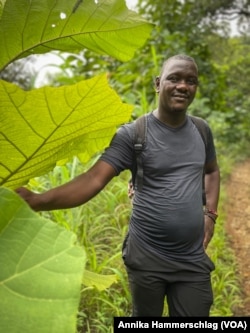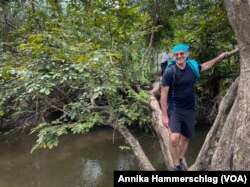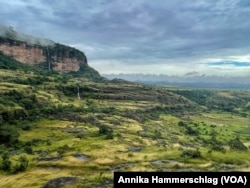With its lush forests, abundant waterfalls and flamboyant birds, Guinea is the type of tropical paradise that draws tourists. But the West African country has few visitors and earns almost all its foreign revenue from mining, which can damage that environment. Now some are working to change that.
Guinean tour guide Mohammed Camara balances precariously on a slippery rock as water gushes around him and the three foreigners he’s leading on a hike. Below, the water slices through the cliff making way for a spectacular view of the forest.
He dreams of there one day being a boardwalk that spans the top of the waterfall so his clients don’t have to slip and slide to reach the view. Guinea’s government is more focused on developing the country’s mining industry than on creating ecotourism projects, he says.
“When people talk about mines, everyone talks about Guinea. But when people talk about tourism we don't talk about Guinea,” Camara said. “And yet there is great potential for tourism in this country that could employ more people than mines and bring in much more money.”
Guinea is the world’s second largest producer of bauxite, the primary ore used to produce aluminum. The country is also rich in iron ore deposits as well as other minerals such as gold and diamonds.
Mining comprises about 25 percent of the country’s Gross Domestic Product, yet Guinea remains one of the poorest countries in the world with more than half the population living below the poverty line.
A 2018 report by Human Rights Watch found Guinea’s mining industry had destroyed ancestral farmlands, polluted water sources and blanketed villages and crops in dust. The environmental destruction of bauxite mining can be so severe it led Malaysia to implement an export ban in 2016.
François Kieffer is the operations manager for Belgian development agency Enabel in Guinea.
In September he helped launch an ecotourism project in Kindia – a forested region about 130 kilometers from Conakry with a high potential to attract tourists.
The project is focused on the construction of facilities that make sightseeing more accessible, such as boardwalks and trail signs, as well as the training of tour guides.
Kieffer said he hopes the projects will provide an alternative to environmentally destructive practices beyond mining, such as slash and burn agriculture and charcoal production.
“Today, human activity puts a lot of pressure on the environment and we realized that it’s the local people who are the first victims of these types of activities,” he said. “The potential for tourism here is incredible.”
Sites such as the breathtaking Mount Gangan and the pristine swimming holes beneath Kilissi Falls are largely unknown outside of Guinea.
From 2010 to 2017, the country saw an average of just 65,000 tourists per year – one-sixteenth the number who visited neighboring Senegal.
“In Kindia, there are a lot of sites that are beloved by the locals. But because those sites aren’t developed, people are afraid to go,” said Sekou Camara, a local development officer in Guinea’s Linsan sub-prefecture. “If we succeed in developing them, Kindia could become attractive. But for now people are prioritizing the mines.”
He motions to the waterfalls plunging down the verdant face of Mount Gangan. That could be Guinea’s crown jewel, he says.









